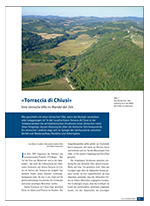 M. Cavalieri, A. Giumlia-Mair, J. Hamacher, Torraccia di Chiusi» Eine römische Villa im Wandel der Zeit, Antike Welt 3, 2011, p. 39-45 (en allemand).
M. Cavalieri, A. Giumlia-Mair, J. Hamacher, Torraccia di Chiusi» Eine römische Villa im Wandel der Zeit, Antike Welt 3, 2011, p. 39-45 (en allemand).
PDF : AW-2011

Villa romaine d'Aiano-Torraccia di Chiusi
Une villa de l'Antiquité tardive au coeur de la Toscane
 M. Cavalieri, A. Giumlia-Mair, J. Hamacher, Torraccia di Chiusi» Eine römische Villa im Wandel der Zeit, Antike Welt 3, 2011, p. 39-45 (en allemand).
M. Cavalieri, A. Giumlia-Mair, J. Hamacher, Torraccia di Chiusi» Eine römische Villa im Wandel der Zeit, Antike Welt 3, 2011, p. 39-45 (en allemand).
PDF : AW-2011
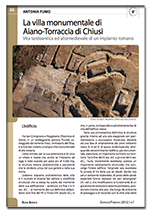 A. Fumo, La villa monumentale di Aiano-Torraccia di Chiusi. Villa tardoantica ed altomedievale di un impianto romano, Runa Bianca 7, janvier-février 2012, p. 50-53 (en italien).
A. Fumo, La villa monumentale di Aiano-Torraccia di Chiusi. Villa tardoantica ed altomedievale di un impianto romano, Runa Bianca 7, janvier-février 2012, p. 50-53 (en italien).
PDF : RB-5-2011
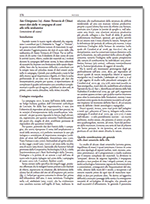 M. Cavalieri et alii, San Gimignano (SI). Aiano-Torraccia di Chiusi: nuovi dati dalla VI campagna di scavi alla villa tardoantica, NSBAT 6, 2011, p. 376-379.
M. Cavalieri et alii, San Gimignano (SI). Aiano-Torraccia di Chiusi: nuovi dati dalla VI campagna di scavi alla villa tardoantica, NSBAT 6, 2011, p. 376-379.
PDF : NSBAT-6-2011
Rapport sur les découvertes et progrès de la fouille en 2010 publié dans le Notiziario della Sopraintendenza per i Beni Archeologici della Toscana.
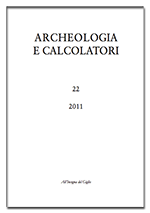 M. CAVALIERI, G. PACE. 2011. Metodologie geofisiche a confronto presso la villa tardoantica di Aiano-Torraccia di Chiusi (Siena) : qualche nota su efficacia e limiti. Archeologia e calcolatori 22, p. 283-306 (in italiano).
M. CAVALIERI, G. PACE. 2011. Metodologie geofisiche a confronto presso la villa tardoantica di Aiano-Torraccia di Chiusi (Siena) : qualche nota su efficacia e limiti. Archeologia e calcolatori 22, p. 283-306 (in italiano).
PDF : ART-AC-22-2011
During the years 2006-2007, three teams of scientists (archaeologists with geophysicists) detected the archaeological surface of the Late Antique villa at Aiano-Torraccia di Chiusi (Siena, Tuscany) using GPR (Ground Penetrating Radar), Resistivity and Magnetometry. Their aim was to identify archaeological remains and consequently spend less time and money on digging. At the conclusion of the fieldwork and data treatment, they used a CAD program to overlap geophysical and archaeological layers and check geophysical results on archaeological remains. Despite surveys in many other archaeological sites, they obtained few results: surveys located anomalies in less than 1/4 of the archaeological remains excavated in 2008 and 2009. In this paper the authors attempt to analyze (and try to find better solutions for the future) errors in the geophysical surveys caused by incorrect calibration of the database, low accuracy of grid intersections and excessively long grid lines, in relationship to site conditions and the kinds of archaeological remains. These technical problems in fact certainly create a less than optimal operational synergy between archaeologists and geologists during the post-processing of the data: an analysis of these problems may help to improve future projects of this type.
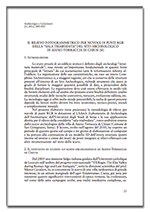 A. ARRIGHETTI, M. CAVALIERI. 2012. Il rilievo fotogrammetrico per nuvole di punti RGB della « sala triabsidata » del sito archeologico di Aiano-Torraccia di Chiusi (SI). Archeologia e calcolatori 23, p. 21-33 (in italiano).
A. ARRIGHETTI, M. CAVALIERI. 2012. Il rilievo fotogrammetrico per nuvole di punti RGB della « sala triabsidata » del sito archeologico di Aiano-Torraccia di Chiusi (SI). Archeologia e calcolatori 23, p. 21-33 (in italiano).
PDF : ART-AC-18-2012
Reconstructing the development of architectural complexes throughout time is often very diffcult. Buildings are usually a series of constructive actions, changes from the original project, and also collapses and reconstructions due to human actions (such as demolitions) and/or natural (earthquakes, foods, etc.). The building’s structure records all these events, giving us the chance to understand and decode them through the relief. The archaeological relief is thus supposed to offer a complete and rapid documentation. At the same time, it must be enriched with all the information needed for a deeper analysis of the archaeological object itself. In the last years, the introduction and continuous improvements of many instruments (e.g. laser scanners and photogrammetric technologies) have led to a sensible qualitative and quantitative change in the recording of the material structure.
In particular, the possibility to combine different relief technologies – obtaining high resolution, 3D geometrically correct models of buildings or of entire archaeological sites (which could be further investigated thanks to archaeological analysis or other procedures), has modified the archaeological approach towards the material “datum” and its divulgation. In order to achieve a better knowledge of nowadays technologies, the divulgation of different employed methodologies – through their application in research contexts – is the best way of transmission and comparison. This contribution is dedicated to the presentation and detailed analysis of a photogrammetric RGB point-clouds technology, used for the relief of a living-room during the archaeological excavation at Aiano-Torraccia di Chiusi (City of San Gimignano).
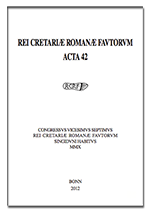 M. Cavalieri, E. Boldrini, C. Bossu, P. De Idonè & A. Fumo, Aspetti della cultura materiale nelle fasi di riutilizzo (V–inizi VII sec. d.C.) della villa romana di Aiano-Torraccia di Chiusi (San Gimignano, Siena/Italy). Note preliminari dans REI CRETARIÆ ROMANÆ FAVTORVM ACTA 42, Bonn 2012, p. 169-180.
M. Cavalieri, E. Boldrini, C. Bossu, P. De Idonè & A. Fumo, Aspetti della cultura materiale nelle fasi di riutilizzo (V–inizi VII sec. d.C.) della villa romana di Aiano-Torraccia di Chiusi (San Gimignano, Siena/Italy). Note preliminari dans REI CRETARIÆ ROMANÆ FAVTORVM ACTA 42, Bonn 2012, p. 169-180.
Pdf : ART-RCRF-42-2012
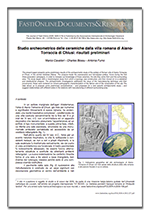 M. Cavalieri, A. Fumo, C. Bossu, 2012. Studio archeometrico delle ceramiche dalla villa romana di Aiano-Torraccia di Chiusi: risultati preliminari. FOLD&R 257. [en italien]
M. Cavalieri, A. Fumo, C. Bossu, 2012. Studio archeometrico delle ceramiche dalla villa romana di Aiano-Torraccia di Chiusi: risultati preliminari. FOLD&R 257. [en italien]
PDF ici
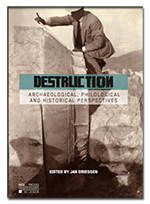 M. Cavalieri, Destruction, transformation et refonctionnalisation. Le passage de l’Antiquité au Moyen-âge en Toscane entre les IVe et VIIe s. p.C.n. dans J. Driessen (ed.), Destruction. Archaeological, philological and historical perspectives, Louvain, 2013.
M. Cavalieri, Destruction, transformation et refonctionnalisation. Le passage de l’Antiquité au Moyen-âge en Toscane entre les IVe et VIIe s. p.C.n. dans J. Driessen (ed.), Destruction. Archaeological, philological and historical perspectives, Louvain, 2013.
Publication de la contribution de M. Cavalieri au colloque « Destruction. Archaeological, philological and historical perspectives » qui s’est tenu à Louvain-la-Neuve du 24 au 26 novembre 2011.
Le podcast de la conférence est toujours accessible.
L’ouvrage peut être commandé aux Presses Universitaires de Louvain.
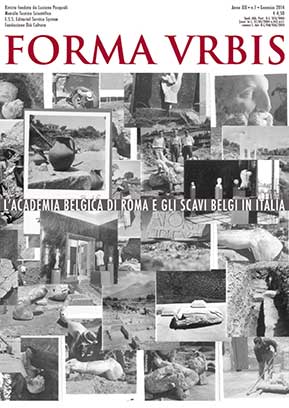 Dans le numéro de janvier de la revue italienne « Forma Urbis », consacré à l’Academia Belgica et aux fouilles belges en Italie, vous trouverez un article sur les fouilles à Aiano-Torraccia di Chiusi, ainsi que celles de Cures Sabini (les deux projets dirigés par M. Cavalieri et animés par le même groupe de recherche). En cliquant sur la couverture, vous aurez accès au sommaire du numéro et à la première page de l’article.
Dans le numéro de janvier de la revue italienne « Forma Urbis », consacré à l’Academia Belgica et aux fouilles belges en Italie, vous trouverez un article sur les fouilles à Aiano-Torraccia di Chiusi, ainsi que celles de Cures Sabini (les deux projets dirigés par M. Cavalieri et animés par le même groupe de recherche). En cliquant sur la couverture, vous aurez accès au sommaire du numéro et à la première page de l’article.
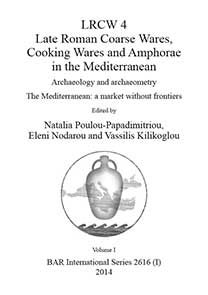 THE AMPHORAE IN THE ROMAN VILLA AT AIANO-TORRACCIA CHIUSI (SAN GIMIGNANO, SIENA-ITALY)
THE AMPHORAE IN THE ROMAN VILLA AT AIANO-TORRACCIA CHIUSI (SAN GIMIGNANO, SIENA-ITALY)
in LRCW 4. Late Roman Coarse Wares, Cooking Wares and Amphorae in the Mediterranean Archaeology and archaeometryThe Mediterranean: a market without frontiers. Edited by Natalia Poulou-Papadimitriou, Eleni Nodarou and Vassilis Kilikoglou. Volume I. BAR International Series 2616 (I) 2014.
Abstract :
Since 2005 a Belgian-Italian research team has undertaken an archaeological excavation on the site of a villa longinqua, a building erected between the late 3rd and the early 4th centuries AD. The research project was funded by the Université catholique de Louvain and was part of the international project VII Regio. Valdelsa during the Roman Age and late Antiquity. This site shows monumental features, and at the end of the 4th century AD underwent major restoration. It was then abandoned one century later, when it was ravaged and most of the marble building-material was taken away. Between the 6th and the 7th centuries AD, the site was occupied by craftsmen, who established several workshops for metal manufacturing (including iron, gold, lead and probably bronze), as well as glass and ceramics kilns. These craftsmen used the building material of the villa as raw materials. The majority of the amphorae recovered during the excavation dates between the beginning of the 5th century and the early 7th century AD, but only spatheia amphorae were found in layers dating to the period during which these objects were actually produced and circulated. All the other amphorae (and perhaps the spatheia also) might have been reused in the workshops. The shapes of these amphorae imply commercial contacts with Hispania and Africa, placing the villa within a Mediterranean trade network.